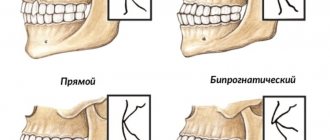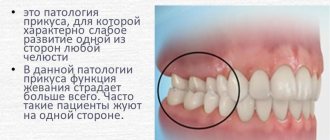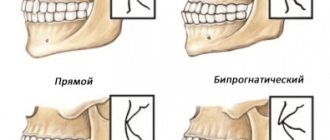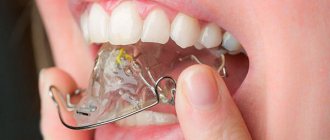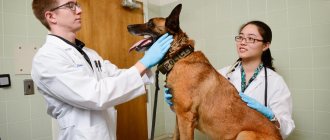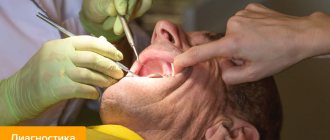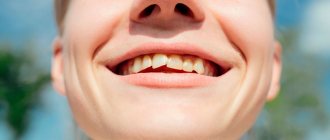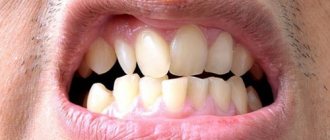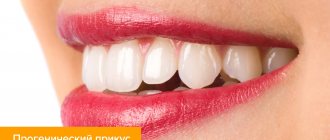Bite pathologies are one of the most common reasons for visiting a dentist. People have been engaged in returning teeth “to their place” since ancient times - there is evidence that this issue was of interest in ancient Egypt. However, only in recent decades have doctors come to the conclusion that it is necessary to correct an abnormal bite. Timely orthodontic treatment helps to avoid serious consequences for the entire body in the future. In this article, the leading orthodontist at the ZUUB dental clinic on Lipetskaya in Moscow, Dmitry Anatolyevich Polovkov, talks about the dangers of malocclusion and ways to correct it.
Correct bite - what is it?
Normal, or physiological occlusion, is characterized by the absence of disturbances in the arrangement of the dentition relative to each other with the jaws fully closed. He can be:
- regular, or orthognathic - in this case, the upper teeth overlap the lower teeth by a third of their height and there are no pronounced gaps between the dentition;
- straight - both jaws clearly close;
- biprognathic - both the upper and lower dentition are slightly tilted forward;
- progenic - only the lower jaw is pushed forward a little, but this does not prevent the cutting edges of the teeth from completely closing.
Correct bite is the absence of pronounced gaps between the teeth when the upper teeth are in contact with the lower ones opposite them. Orthodontists determine a bite without pathologies based on the following characteristics.
- The upper front teeth overlap the lower ones by 1/3 of their height.
- The incisors and canines are arranged in an even, arched line without distortions or crevices.
- The upper teeth protrude slightly outward, the lower teeth “look” slightly inward.
- All teeth are clearly below each other.
- The center of the jaws vertically coincides with the midline of the face, there are no protruding parts of the cheekbones or chin.
It is important to remember that in order to form a correct bite, you need to be careful about teething and caring for them.
The list of dental pathologies that can be successfully corrected with aligners is very wide.
You can see the same visualization of the treatment result with:
- See how teeth are corrected in case of crossbite. Orthodontist Alexander Veniaminovich Spesivtsev comments
- Watch a video about the movement of canines in case of rotation and treatment with Star Smile aligners. Orthodontist Alexander Veniaminovich Spesivtsev comments on dental rotations. In case of displacement and rotation of fangs
- See how the lower teeth move back to normal when treating crossbite with Star Smile aligners. Orthodontist Alexander Veniaminovich Spesivtsev comments on crossbite of the lower teeth
- Watch the video of how the central upper incisors fall into place during treatment with Star Smile aligners. Orthodontist Alexander Spesivtsev comments on the correction of the central upper incisors. Very common
- And many, many others
Now - about the promised pleasant things. In the clinics of Star Smile’s partners, such a virtual 3D setup can be done for you absolutely FREE
. That is, you will be able to see your future straight teeth and your smile and decide whether you need to deal with crooked teeth at all or leave everything as it is.
How can you make a FREE virtual 3D setup?
- Call 8
, Star Smile specialists will explain everything to you in detail and make an appointment with a doctor in your city. We work in more than 70 cities of Russia. - Or - fill out the form located below after the article and also wait for information from Star Smile specialists
In some cases, it’s up to you to decide which method you personally choose to correct a malocclusion—braces or aligners. And in case of severe pathologies of malocclusion, the decision will be made by your attending physician. Do not start the development of malocclusion; consult an orthodontist in a timely manner.
How is the 3D setup removed? Everything is very simple. Watch the video:
Using the example of crowded teeth in the upper jaw, orthodontist Valeria Zhenzerova shows
Below you see a simple form, by filling it out you will take the first step towards your beautiful smile. So, go ahead!
Causes of malocclusion
Malocclusion (malocclusion) is due to various reasons: congenital or acquired. An important role is played by genetic factors, as well as insufficient intake of calcium into the mother’s body when carrying a child. Hereditary problems with bite require certain nuances in treatment. Therefore, before carrying out any orthodontic manipulations, the doctor talks with the parents and learns about all the possible factors in the occurrence of pathology.
Acquired malocclusion develops gradually. It appears at different ages due to its own reasons.
In childhood
- Bad habits (finger sucking, pacifiers, chewing on objects).
- Being on artificial feeding.
- Pathological bone formation.
- Teeth grinding (bruxism).
- Lack of sufficient solid food in the child's diet.
- Mouth breathing (formed as a habit or due to respiratory diseases).
- The replacement of baby teeth occurs too sooner or later.
- Pathologies associated with metabolism.
- Calcium and fluoride deficiency.
- Pronounced carious lesion.
- Injuries of the maxillofacial apparatus
In adults
- Installation of unsuitable dentures.
- Diastemas that form as a result of tooth extraction.
- Various types of injuries.
- Lack of space for eights (wisdom teeth).
- Unusual localization of the language.
- Diseases of the musculoskeletal system.
Bite in the absence of teeth
It’s interesting, but even if you have no teeth at all, there is no guarantee that with prosthetics you will be able to create the right jaw . It all depends on how damaged the dental system was before removing all its elements. If the jaws are within normal limits relative to each other, the doctor will be able to make adjustments to the prosthesis. If there are also problems with the bones, more complex methods of restoring the dentition will be necessary.
In the absence of teeth, the bite in people is determined using special wax rollers that are placed in the mouth and allow measurements to be taken. The instruments used are a ruler arc and an intraoral plate. Next, a plaster and then a regular prosthesis is created.
Types of malocclusion in adults and children
Dentists usually divide anomalous occlusions into planes.
- Sagittal - characterized by elongated/shortened rows of teeth.
- Transversal - narrowed/expanded dentition is visible.
- Vertical - the presence of shortened/elongated certain areas in the dentition.
In addition, in dental practice it is customary to use the following classification of occlusion.
- Distal.
Sagittal occlusion with the upper jaw pushed forward. - Mesial.
Also a sagittal variety, but with the lower jaw moving forward. - Cross.
Transversal pathology with displacement of the jaws, which can only be partially formed, in one direction or another. - Open.
Vertical occlusion occurs with both partial and complete non-occlusion of teeth. - Deep.
The so-called traumatic, contributing to damage to the enamel. Characteristic is almost maximum overlap of the lower rows with the upper ones. - Vertical occlusal anomaly.
In addition to the above listed occlusion disorders, some experts identify 2 more types of anomalies:
- dystopic bite - displacement of one or more teeth;
- reducing - formed due to damaged and (or) lost teeth.
Tests to determine malocclusion
When diagnosing bite pathologies, specialists use various research methods. There are already developed tables with which you can identify even minimal deviations and prevent its development at an early stage.
Tests for malocclusion are performed both by direct examination and by dental impressions. In the process, measurements are taken in various planes, and attention is paid not only to the dentition as a whole, but to the presence and location of each tooth, as well as their general condition.
Important! Even if there is no visually noticeable bite pathology, it is imperative to visit a specialist and undergo testing. It will help identify the development of anomalies at the initial stage, when deviations are minimal.
How to correct a child's malocclusion
- Children under 7 years of age
are shown a set of gymnastic exercises and massage that will help solve the problem. - Children under 10 years of age
are already prescribed trainers, with the help of which they can set the desired direction for their teeth. They must be worn for a certain number of hours during the day. But, if the pathologies are more advanced, removable plates and mouthguards are used. Correction of the anomaly takes approximately 2 years. - For children aged 10-12
years, braces are used to correct their bite - special orthodontic structures consisting of a power arch and clasps that set an individual direction for each tooth. They cannot be placed at an earlier age; it is necessary that all milk teeth be replaced by permanent ones. How long to wear braces for malocclusion is determined by the treating orthodontist.
How to correct malocclusion in an adult
A very common treatment method for adults is wearing braces. Transparent aligners (aligners) are also very popular now. They are made of transparent plastic material. Aligners are effective in correcting impaired occlusion, are easy to use and look very aesthetically pleasing. All details about this technique can be found here.
In cases where the patient is not in the mood for long-term bite correction with aligners or braces, there is another solution - microprosthetics. In this case, special overlays are installed on the teeth - veneers, with the help of which you can correct uneven teeth and gaps between them. But if there are serious malocclusions, this technique is not used.
There are bite defects for which only surgical treatment is indicated. Examples include: severe malocclusion, facial asymmetry due to trauma or hereditary causes, and chin dysplasia.
Each method of orthodontic treatment has both indications and contraindications. Only an orthodontist can determine the method of treatment after a thorough examination and full diagnosis.
Treatment methods
Treatment of occlusion is divided into an active period and a period of retention (consolidation of the result).
Depending on the patient’s situation, at the active stage the doctor can offer him several correction options:
- aligners (aligners),
- trainers,
- records;
- orthodontic devices;
- braces,
- surgical intervention.
Mouth guards
They are transparent soft plates made of silicone, polyurethane and other material, made for a specific person. They are worn for at least 22 hours, removed for eating and brushing teeth. They are practically invisible in the mouth, wear comfortably and do not cause harm to the oral cavity. Every 3 weeks they change to harder ones.
In case of serious pathology, mouthguards are ineffective. They show good results only in cases of crowded teeth, narrow or wide arches, and recurrent displacement. Combined with their high cost, aligners are rarely prescribed or as a preventive measure.
Trainers
The silicone device is similar to a mouthguard, but much more massive. Trainers are intended to be worn at night; during the day they should be used for no more than 4 hours. They cope, again, only with minor bite defects.
The listed systems are best suited for patients under 12 years of age. At an older age, they are prescribed to consolidate the result of correction or prevention.
Braces
Braces are prescribed to adolescents or adult patients for almost any malocclusion pathology. In children, the jaw is actively growing, so they are prescribed to wear removable plates.
Externally, braces are plates connected by an arc. They are attached to the tooth(s) using medical adhesive.
The whole secret of alignment is in the arc. Possessing shape memory, it tries to return to its original state, being deformed when installed on a problematic tooth or teeth.
Important! At the very beginning of treatment, the system is elastic. Over time, it is replaced with a tougher one.
Braces are classified as follows:
- Depending on the place of attachment - vestibular and lingual. The first are installed on the outside of the teeth, the second - on the inside. The latter are invisible, but can cause discomfort to the patient, since the tongue is constantly in contact with them. Because of this, diction may be temporarily impaired. In addition, they are more expensive to maintain than vestibular ones.
- According to the method of attaching braces to the power arch - ligature, non-ligature, self-adjusting. The first ones are considered classics. Fastening is provided by ligatures (metal wire) or elastic rings. At a fairly low cost, they show good results. However, ligature braces require frequent visits to the orthodontist and thorough cleaning to avoid discoloration. In addition, correction with their help is quite unpleasant. In non-ligature models, the arc is secured using special movable clamps (latches, latches, etc.). It is not so hard, which reduces discomfort. And the braces themselves do not take up much space on the teeth. It is much easier to care for and adjust them in the dentist’s office. It is not surprising that they are more expensive than ligature ones. But the most expensive models are self-regulating. They are made individually, taking into account what the teeth should look like after treatment. During wear, frequent visits to the orthodontist are not required. In addition, there is no danger of injury to the mucous membranes.
- Depending on the material : plastic, metal, ceramic, titanium, sapphire, silicone. The first ones are the most accessible and inconspicuous, but they can change color and are fragile. Metal ones are also available, and are much stronger, but are visible on the teeth. Braces made of polycrystalline ceramics are matched to the natural color of the enamel, are invisible and wear well, but can change color under the influence of food and drinks. Silicone ones are much softer, but are rarely used. The most expensive product is made from artificial sapphires. At the same time, they require careful hygiene and careful use. Titanium braces are hypoallergenic, lightweight and secure, but again, noticeable.
The price of a bracket system depends on its type and the material used.
Any of the above requires careful care. They should be cleaned with special brushes for 7-10 minutes in the morning, evening, and after each meal.
Important! With age, contraindications to the use of certain systems arise. In addition, the older the patient, the more difficult it is to change the position of the teeth and affect the bone tissue. Therefore, it is necessary to correct the bite, even with the help of braces, as early as possible.
During the period of retention (consolidation of the result), the patient is prescribed to wear mouth guards or trainers. This period lasts approximately as long as the braces were worn.
Surgical intervention
A radical method is resorted to if the bite is severely deformed and all the above methods of correction will not give results.
The intervention is accompanied by an incision in the gums and bone tissue in order to close the jaws and return the correct position of the teeth.
Malocclusion is a serious problem that can best be corrected in childhood. For this, various devices can be used (from mouth guards and plates to braces). The process will take a year or two, but will correct the bite and prevent complications in the future.
The older a person is, the more contraindications he has for certain corrective interventions. In addition, correction requires more time and effort for both the patient and the orthodontist.
Consequences of malocclusion
It is a mistake to think that a pathological bite concerns only appearance and only leads to an unattractive smile. This is where the problems arise that are more serious. For example, in 90% of people with abnormal occlusion, incorrect posture is also detected. There is a logical explanation for this: with a broken bite, the center of gravity of the head shifts. This in turn affects the compensation mechanisms of the musculo-ligamentous apparatus of the maxillofacial system. The result of all this is an increase in the pathology of teeth closure.
Aesthetically, occlusion abnormalities lead to facial asymmetry. A weak-willed chin becomes pronounced, and lips protrude unattractively.
What is the danger of malocclusion?
In addition to visual problems, more serious dysfunctions often occur, including internal organs.
- Due to increased and uneven load on the teeth, periodontal disease develops and teeth begin to decay.
- Inadequate chewing of food leads to disruption of the digestive system.
- The functioning of the temporomandibular joint is impaired.
- The respiratory system also begins to malfunction.
- Slow metabolism.
- Increased risk of developing caries, especially with cross-closing teeth.
- Problems with pronunciation of sounds.
In addition, with malocclusions, daily dental care becomes much more difficult, which contributes to the constant accumulation of plaque on them.
Make an appointment
right now!
Polovkov Dmitry Anatolievich
Orthodontist
What to do to avoid malocclusion.
The consequences of malocclusion can be avoided by taking measures in time, namely in childhood. Here the responsibility falls largely on parents, who can promptly pay attention to problems and carry out prevention. It is important to take into account the risk of congenital disorders, hereditary predisposition, and also eliminate unfavorable factors:
- prevent the development of rickets and other diseases that impair bone growth;
- bottle feed your baby correctly;
- monitor the position of the child’s body during sleep (posture without tension, head not tilted back, etc.);
- maintain correct posture;
- timely wean your child off the pacifier, thumb sucking habit, toys and other objects;
- treat baby teeth immediately, because their early loss (as well as too late) can negatively affect the bite;
- to prevent nasal breathing disorders, namely to treat diseases of the ENT organs and ARVI.
When anomalies in the development of teeth are identified in childhood, timely assistance from an orthodontist will help solve problems faster than in advanced cases in adults. In children, as a rule, there is no need for surgical intervention yet, and even a complex of therapeutic exercises for the facial muscles can significantly help in correcting the bite.
Publisher: Expert magazine about dentistry Startsmile.ru
Conclusions. Expert advice
The correct position of teeth is very important for a person. Bite abnormalities can cause improper development of the jaw, rapid wear of the enamel, and the development of dental diseases, which is why they have to be removed. If you do not pay attention to the problem, it begins to cause disturbances in the gastrointestinal tract, breathing problems, and ENT diseases. That is why it is important to diagnose the anomaly in a timely manner and begin treatment for malocclusion. Moreover, you can take care of your smile at any age; modern medicine allows you to do this!
